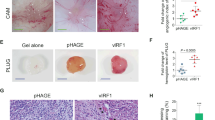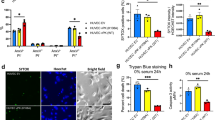Abstract
Conditionally replicating adenoviruses (CRADs) are a novel strategy in cancer treatment and clinical trials using CRADs targeted to tumor cells have been reported recently. We hypothesized that it would be possible to construct CRADs targeted to dividing endothelial cells, which are present in the tumor endothelium. We utilized the regulatory elements of Flk-1 and endoglin genes, which have been shown to be highly overexpressed in angiogenic endothelial cells, to construct two CRADs: Ad.Flk-1, which has adenoviral E1A gene under the control of the Flk-1 enhancer/promoter, and Ad.Flk-Endo, which harbors the same Flk-1 enhancer/promoter as Ad.Flk-1, plus it has the adenoviral E1B gene under control of the endoglin promoter. Viral titer measurements by plaque assay showed that in human umbilical vein endothelial cells (HUVECs), both CRADs replicated at levels comparable to that of wild-type adenovirus. In Flk-1 and endoglin negative Hep3B and A549 cells, however, the replication of Ad.Flk-1 and Ad.Flk-Endo was reduced by 30-fold and 600-fold, respectively. Cytotoxicity assays demonstrated that both CRADs killed HUVECs as effectively as wild-type adenovirus and their cytotoxicity in Hep3B and A549 cells was comparable to nonreplicating control adenovirus. Furthermore, there was a striking inhibition (83–91%) of capillary network formation in an in vitro angiogenesis assay when HUVECs were infected with Ad.Flk-1 or Ad.Flk-Endo as compared with the nonreplicating control virus. These results demonstrate that CRADs can be transcriptionally targeted to dividing endothelial cells with high specificity, and that the combined use of Flk-1 and endoglin regulatory elements has a synergistic effect on targeting specificity. This principle may be incorporated into novel therapeutic agents to develop anti-angiogenic treatment for cancer.
This is a preview of subscription content, access via your institution
Access options
Subscribe to this journal
Receive 12 print issues and online access
$259.00 per year
only $21.58 per issue
Buy this article
- Purchase on Springer Link
- Instant access to full article PDF
Prices may be subject to local taxes which are calculated during checkout






Similar content being viewed by others
References
Heise C, Kirn DH . Replication-selective adenoviruses as oncolytic agents J Clin Invest 2000 105: 847–851
Alemany R, Balague C, Curiel DT . Replicative adenoviruses for cancer therapy Nat Biotechnol 2000 18: 723–727
Kirn D, Martuza RL, Zwiebel J . Replication-selective virotherapy for cancer: biological principles, risk management and future directions Nat Med 2001 7: 781–787
Hernandez-Alcoceba R, Pihalja M, Wicha MS, Clarke MF . A novel, conditionally replicative adenovirus for the treatment of breast cancer that allows controlled replication of E1a-deleted adenoviral vectors Hum Gene Ther 2000 11: 2009–2024
Hallenbeck PL et al. A novel tumor-specific replication-restricted adenoviral vector for gene therapy of hepatocellular carcinoma Hum Gene Ther 1999 10: 1721–1733
Kurihara T, Brough DE, Kovesdi I, Kufe DW . Selectivity of a replication-competent adenovirus for human breast carcinoma cells expressing the MUC1 antigen J Clin Invest 2000 106: 763–771
Yu DC et al. The addition of adenovirus type 5 region E3 enables calydon virus 787 to eliminate distant prostate tumor xenografts Cancer Res 1999 59: 4200–4203
Rodriguez R et al. Prostate attenuated replication competent adenovirus (ARCA) CN706: a selective cytotoxic for prostate-specific antigen-positive prostate cancer cells Cancer Res 1997 57: 2559–2563
Heise C et al. An adenovirus E1A mutant that demonstrates potent and selective systemic anti-tumoral efficacy Nat Med 2000 6: 1134–1139
Bischoff JR et al. An adenovirus mutant that replicates selectively in p53-deficient human tumor cells Science 1996 274: 373–376
Khuri FR et al. A controlled trial of intratumoral ONYX-015, a selectively replicating adenovirus, in combination with cisplatin and 5-fluorouracil in patients with recurrent head and neck cancer Nat Med 2000 6: 879–885
Nemunaitis J et al. Selective replication and oncolysis in p53 mutant tumors with ONYX-015, an E1B-55kD gene-deleted adenovirus, in patients with advanced head and neck cancer: a phase II trial Cancer Res 2000 60: 6359–6366
Folkman J . Angiogenesis in cancer, vascular, rheumatoid and other disease Nat Med 1995 1: 27–31
Hanahan D, Folkman J . Patterns and emerging mechanisms of the angiogenic switch during tumorigenesis Cell 1996 86: 353–364
Carmeliet P, Jain RK . Angiogenesis in cancer and other diseases Nature 2000 407: 249–257
Risau W . Mechanisms of angiogenesis Nature 1997 386: 671–674
Brower V . Tumor angiogenesis – new drugs on the block Nat Biotechnol 1999 17: 963–968
Feldman AL, Libutti SK . Progress in antiangiogenic gene therapy of cancer Cancer 2000 89: 1181–1194
Millauer B et al. High affinity VEGF binding and developmental expression suggest Flk-1 as a major regulator of vasculogenesis and angiogenesis Cell 1993 72: 835–846
Shalaby F . Failure of blood-island formation and vasculogenesis in Flk-1-deficient mice Nature 1995 376: 62–66
Ferrara N . Vascular endothelial growth factor: molecular and biological aspects Curr Top Microbiol Immunol 1999 237: 1–30
Plate KH et al. Up-regulation of vascular endothelial growth factor and its cognate receptors in a rat glioma model of tumor angiogenesis Cancer Res 1993 53: 5822–5827
Kappel A et al. Identification of vascular endothelial growth factor (VEGF) receptor-2 (Flk-1) promoter/enhancer sequences sufficient for angioblast and endothelial cell-specific transcription in transgenic mice Blood 1999 93: 4284–4292
Heidenreich R, Kappel A, Breier G . Tumor endothelium-specific transgene expression directed by vascular endothelial growth factor receptor-2 (Flk-1) promoter/enhancer sequences Cancer Res 2000 60: 6142–6147
Miller DW et al. Elevated expression of endoglin, a component of the TGF-beta-receptor complex, correlates with proliferation of tumor endothelial cells Int J Cancer 1999 81: 568–572
Rius C et al. Cloning of the promoter region of human endoglin, the target gene for hereditary hemorrhagic telangiectasia type 1 Blood 1998 92: 4677–4690
Burrows FJ et al. Up-regulation of endoglin on vascular endothelial cells in human solid tumors: implications for diagnosis and therapy Clin Cancer Res 1995 1: 1623–1634
Douglas JT et al. Efficient oncolysis by a replicating adenovirus (ad) in vivo is critically dependent on tumor expression of primary ad receptors Cancer Res 2001 61: 813–817
Thorpe PE, Burrows FJ . Antibody-directed targeting of the vasculature of solid tumors Breast Cancer Res Treat 1995 36: 237–251
Shayakhmetov DM, Papayannopoulou T, Stamatoyannopoulos G, Lieber A . Efficient gene transfer into human CD34(+) cells by a retargeted adenovirus vector J Virol 2000 74: 2567–2583
Medina DJ et al. Adenovirus-mediated cytotoxicity of chronic lymphocytic leukemia cells Blood 1999 94: 3499–3508
Osborne TF, Gaynor RB, Berk AJ . The TATA homology and the mRNA 5’ untranslated sequence are not required for expression of essential adenovirus E1A functions Cell 1982 29: 139–148
Elliott WL, Roberts BJ, Howard CT, Leopold WR . Chemotherapy with [SP-4-3-(R)]-[1,1-cyclobutanedicarboxylato(2-)](2- methyl-1,4-butanediamine-N,N’)platinum (CI-973, NK121) in combination with standard agents against murine tumors in vivo Cancer Res 1994 54: 4412–4418
Vile RG, Russell SJ, Lemoine NR . Cancer gene therapy: hard lessons and new courses Gene Therapy 2000 7: 2–8
Denekamp J . Review article: angiogenesis, neovascular proliferation and vascular pathophysiology as targets for cancer therapy Br J Radiol 1993 66: 181–196
Mavria G, Porter CD . Reduced growth in response to ganciclovir treatment of subcutaneous xenografts expressing HSV-tk in the vascular compartment Gene Therapy 2001 8: 913–920
Roelvink PW et al. Identification of a conserved receptor-binding site on the fiber proteins of CAR-recognizing adenoviridae Science 1999 286: 1568–1571
Pasqualini R, Koivunen E, Ruoslahti E . Alpha v integrins as receptors for tumor targeting by circulating ligands Nat Biotechnol 1997 15: 542–546
Arap W, Pasqualini R, Ruoslahti E . Cancer treatment by targeted drug delivery to tumor vasculature in a mouse model Science 1998 279: 377–380
Ronicke V, Risau W, Breier G . Characterization of the endothelium-specific murine vascular endothelial growth factor receptor-2 (Flk-1) promoter Circ Res 1996 79: 277–285
Bautista DS, Hitt M, McGrory J, Graham FL . Isolation and characterization of insertion mutants in E1A of adenovirus type 5 Virology 1991 182: 578–596
Acknowledgements
This work was supported in part by Department of Defense Grant DAMD 17-99-1-9307 (to BVS), Academy of Finland fellowship (to MJS) and Leiras Research Foundation Grant (to MJS). We wish to thank Dr Shu-Hsia Chen and Dr Simon Hall for helpful and constructive discussions.
Author information
Authors and Affiliations
Rights and permissions
About this article
Cite this article
Savontaus, M., Sauter, B., Huang, TG. et al. Transcriptional targeting of conditionally replicating adenovirus to dividing endothelial cells. Gene Ther 9, 972–979 (2002). https://doi.org/10.1038/sj.gt.3301747
Received:
Accepted:
Published:
Issue Date:
DOI: https://doi.org/10.1038/sj.gt.3301747



